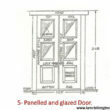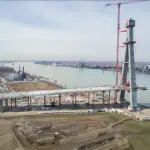The Hong Kong–Zhuhai–Macau Bridge (HZMB) is an extraordinary feat of engineering that connects three major cities in China’s Greater Bay Area. Stretching 55 kilometers (34 miles), it is the world’s longest sea bridge and serves as a crucial link between Hong Kong, Zhuhai, and Macau. Officially opened on October 23, 2018, this megastructure significantly reduces travel time while promoting regional integration and economic growth.

A Hybrid Masterpiece
The bridge’s hybrid design incorporates a combination of bridges, artificial islands, and an underwater tunnel to facilitate both land and maritime transportation. One of its most remarkable features is a 6.7-kilometer (4.2-mile) undersea tunnel, which allows ships to pass through the busy Pearl River Delta without obstruction. This innovative design ensures smooth connectivity while maintaining maritime traffic flow.
Reducing Travel Time and Boosting Connectivity
Before the bridge’s construction, traveling between Hong Kong and Zhuhai required a four-hour journey via ferry or detours through mainland China. With the HZMB, this travel time has been dramatically cut to just 45 minutes, enhancing accessibility for commuters, businesses, and tourists. The bridge is a key component of China’s Greater Bay Area initiative, which aims to integrate major cities into a dynamic economic hub.
Engineering Feats and Challenges
The construction of the HZMB was an ambitious project that took nine years to complete. Engineers faced harsh weather conditions, including the need to withstand typhoons, strong currents, and potential earthquakes. The project required an immense amount of materials, including 420,000 tons of steel—equivalent to 60 Eiffel Towers. Every aspect of its design was carefully crafted to endure the region’s extreme environmental challenges.
A Costly but Strategic Investment
The total cost of the Hong Kong–Zhuhai–Macau Bridge is estimated at $20 billion, making it one of the most expensive infrastructure projects in history. While the project initially faced criticism over its high costs and concerns regarding its usage, it has become a symbol of China’s engineering capabilities and long-term vision for regional development.
A Symbol of Progress
Beyond its practical benefits, the bridge represents China’s commitment to innovation and infrastructure excellence. It not only enhances trade and transportation but also strengthens cultural and economic ties between Hong Kong, Zhuhai, and Macau. As a modern engineering marvel, the HZMB stands as a testament to China’s ambition, technological advancement, and vision for the future.




















